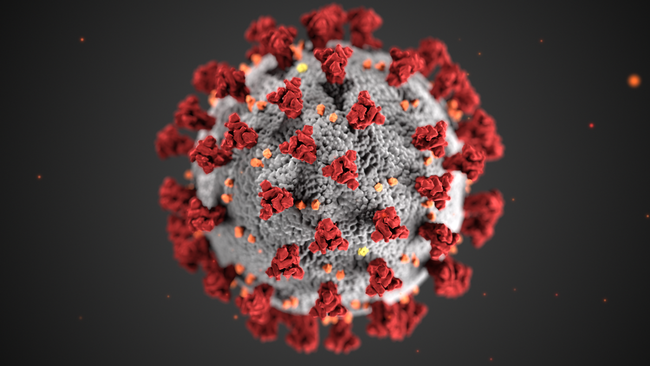- Author: Kathy Keatley Garvey
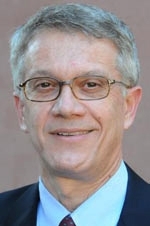
The Academic Senate, acknowledging that the University of California “has a long tradition of service to the state and the people of California” and that “faculty members use their expertise in teaching, research, and professional competence to make unpaid contributions to local, statewide, national, or international public arenas,” annually singles out an exceptional faculty member who “continues the tradition and demonstrate the commitment of UC Davis to public service.”
“Distinguished Professor Walter Leal helped to address the critical need for accurate and accessible COVID-19 information,” according to the Academic Senate notice. “He conceptualized, organized, and moderated four COVID-19 symposia for the public. Through meticulous research, he brought together physicians, former patients, and public health experts to provide the most up-to-date information early in the pandemic, including highlighting equity gaps in treatment.”
“Professor Leal dedicated much of his sabbatical time to developing valuable public resources, thus providing high-quality information during a time of rampant misinformation,” the Academic Senate related. “He also champions global learning, putting long-term efforts into global collaborations to enhance education.”
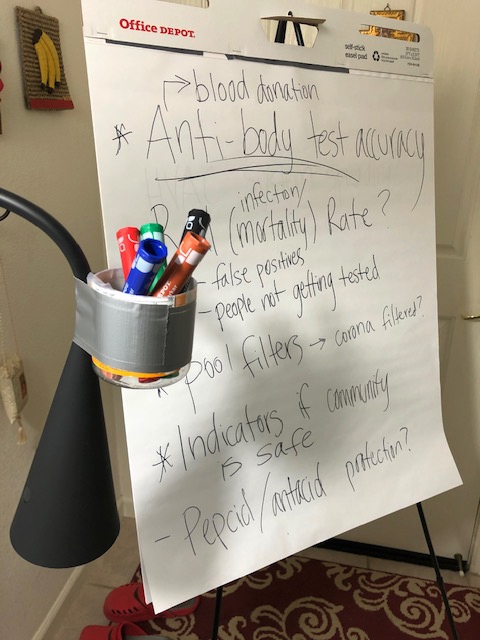
Gov. Gavin Newsom's issued a stay-at-home order on March 19, 2020, and the following day, UC Davis Chancellor Gary May told the campus community: “Most of our employees should already be at home where the governor wants you to be, and where we want you to be, for the sake of your own health and to help limit the spread of the coronavirus.”
“On March 22 came the first reported death from COVID in Yolo County,” wrote Hammock, who holds a joint appointment with the Department of Entomology and Nematology and the UC Davis Comprehensive Cancer Center. “On April 23, Distinguished Professor Walter Leal, as a timely service to the UC Davis community and the general public, organized and moderated the first of his COVID-19 symposiums. What Dr. Leal did, and did so well in the throes of the raging pandemic, was to help the UC Davis community and the general public understand a disease that would go on to claim the lives of nearly 800,000 Americans. Two weeks prior to each symposium, he worked daily from 5 a.m. to 11 p.m., reading the scientific literature, interviewing experts, lining up the speakers; gathering relevant questions from the public, and generally, taking care of all the logistics."
You Are My Heroes. The webinars drew scores of comments. “You are my heroes,” wrote one viewer. “This [the symposium] gave me a sense of hope and calmed my anxiety like nothing else. Part of what has been so hard is all the disinformation and complete lies and contradictions that are happening daily. To hear people, real doctors and scientists who are knowledgeable talk about what is going on and why is so appreciated! I learned so much; wish you were the ones leading [our] government through this! Having a family zoom tonight to relay the info! I (offer) much gratitude to UC Davis! My husband says ditto.”
Professor Leal's plans for a single webinar quickly grew to three more to meet the growing demand of information and translation.
“Few are aware that Dr. Leal interrupted his sabbatical leave to complete his mission,” Hammock pointed out. “Personally, this was not unusual. Having known Dr. Leal for more than two decades, I am fully aware of how altruistic and dedicated he is. He firmly believes that a primary mission of a land-grant university is to serve the public.”
A native of Brazil and fluent in three languages, Leal was educated in Brazil, Japan and the United States, pursuing the scientific fields of chemical engineering, agricultural chemistry, applied biochemistry, entomology and chemical ecology. After serving in a leadership capacity in Japan's Ministry of Agriculture, Forestry, and Fisheries for five years, he joined the Department of Entomology faculty in 2000. Leal chaired the department from 2002 to 2013 before accepting an appointment as a professor of biochemistry with the Department of Molecular and Cellular Biology.
Widely known for his research, teaching and mentorships, Leal is an elected Fellow of the National Academy of Inventors, American Association for the Advancement of Science, California Academy of Sciences, Royal Entomological Society and the Entomological Society of America (ESA). The UC Davis Academic Senate named him the recipient of its 2020 Distinguished Teaching Award for Undergraduate Teaching, and the Pacific Branch of ESA presented him with its 2020 Award of Excellent in Teaching.
A Treasured Note. Leal treasures a handwritten note from a 12-year-old boy, who (according to his mother) was struggling with autism. “Dear Scientist, I hope you can make the vaccine for the coronavirus and to make us live forever,” the boy wrote. “And you can do it. We believe in you. Love XX.”
His mother updated the UC Davis professor in the fall of 2021: “ (XX) wanted me to tell you that he feels so much safer now that he has the vaccine! He is so thankful for all the scientists working so hard to find a solution to make the world safer and continue researching to prevent additional variant outbreaks. He is back in school full time now and is enjoying being able to be with his teachers and classmates.”
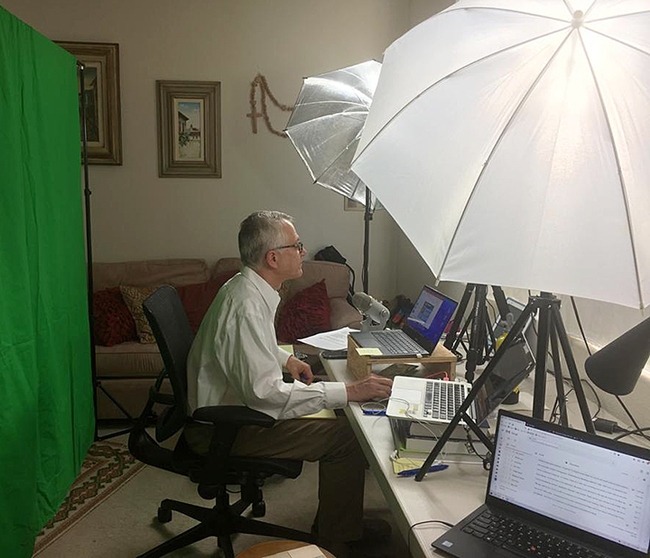
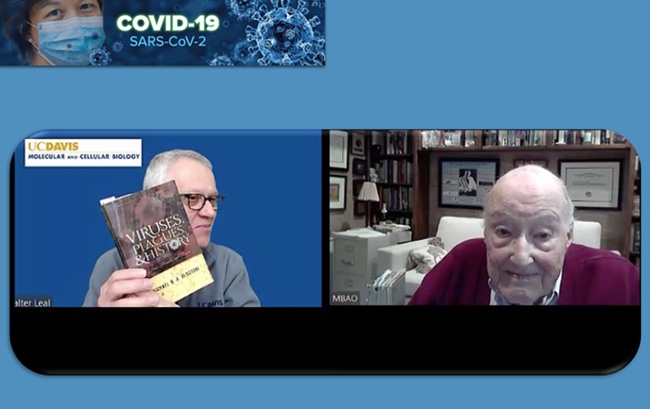
- Author: Kathy Keatley Garvey
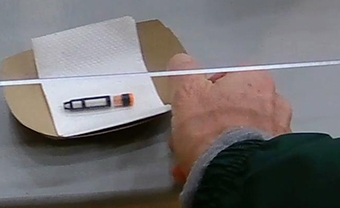
Scientists will share information on COVID-19 saliva, hospital, and sewage surveillance tests--as well as the Healthy Davis Together program--at a UC Davis virtual symposium set for 5 p.m., Wednesday, Jan. 13.
UC Davis Chancellor Gary May will deliver the opening remarks. UC Davis scientists Richard Michelmore, Nam Tran and Heather Bischel will explain the UC Davis COVID tests and answer questions, said UC Davis distinguished professor Walter Leal, who is organizing and moderating the symposium.
The public is invited to submit advance questions and also may ask questions during the symposium via the Zoom chat.
“This symposium will yield important information that everyone should know,” said Leal, a chemical ecologist with the Department of Molecular and Cellular Biology and a former chair of the Department of Entomology, now the Department of Entomology and Nematology. Registration is underway at https://bit.ly/2Li9pnV.
“Registration is required for the symposium, even if you cannot attend the live presentation but are interested in retrieving the symposium video later,” Leal said. This is the fourth in a series of COVID-19 symposiums that he has organized and moderated since April 23. A query from one of his students prompted the Jan. 13 symposium.
Free COVID-19 saliva tests are being administered by appointment to the Davis community--those who live in Davis or work at UC Davis--at testing kiosks on campus. It is a rapid, comprehensive laboratory-developed test that detects whether a person is currently infected with the coronavirus. The UC Davis Genome Center processes the saliva samples. Technically, the test uses a high throughput, real time, quantitative polymerase chain reaction protocol run on machines repurposed from the agricultural genetics industry.
The symposium also will cover how the COVID-19 tests administered in an hospital emergency room or at bedside can distinguish between whether a patient has COVID-19 or the flu. In addition, wastewater surveillance tests, also known as sewage tests, are underway to detect the virus.
“Healthy Davis Together” is a program partnering UC Davis with the City of Davis to prevent the spread of the virus and “to facilitate a coordinated and gradual return to regular city activities and reintegration of UC Davis students back into the Davis community.”
Michelmore, a UC Davis distinguished professor, directs the Genome Center, and holds joint appointments with the College of Biological Sciences, School of Medicine, and the College of Agricultural and Environmental Sciences.
Tran is an associate clinical professor in the Department of Pathology and Laboratory Medicine who specializes in clinical chemistry and point-of-care. Bischel is an assistant professor in the Department of Civil and Environmental Engineering.
Resource:
- All about COVID-19 Saliva Testing on the UC Davis campus (What it's all about and how to make an appointment)
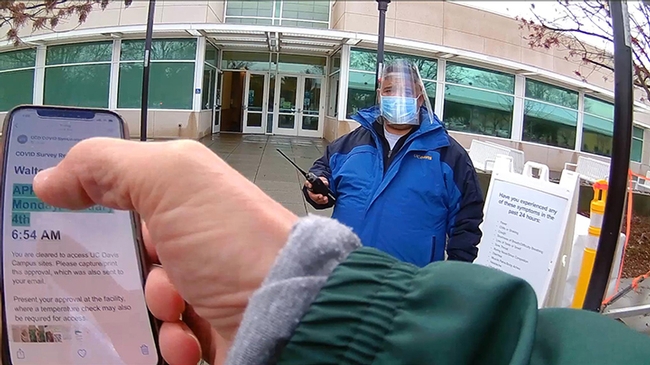
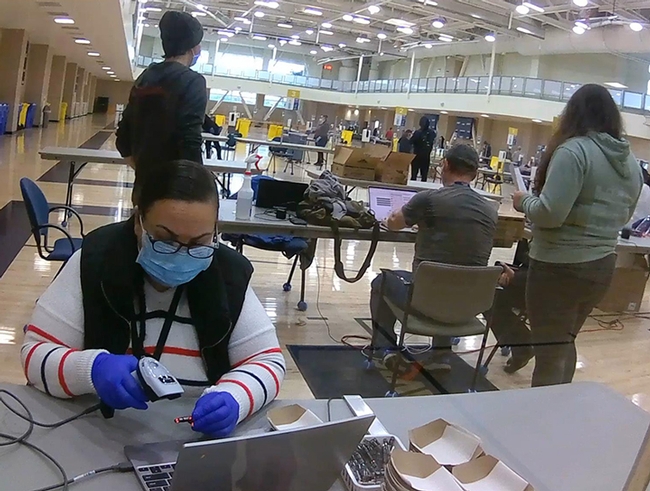
- Author: Kathy Keatley Garvey
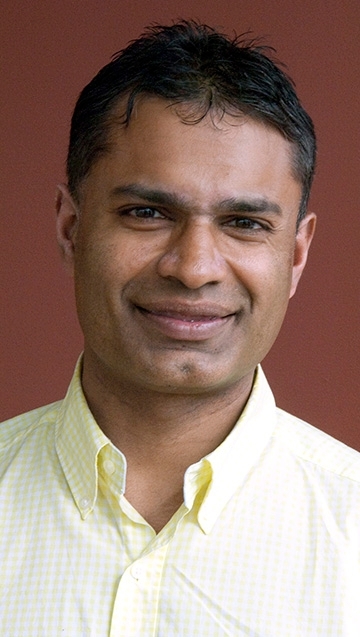
As of July 8, the commentary, “Inflammation Resolution: a Dual-Pronged Approach to Averting Cytokine Storms in COVID-19?”—the work of a nine-member team of Harvard University and UC Davis researchers—has been downloaded 11,444 times since its publication May 8, 2020. It is online at https://rdcu.be/b33IN.
In comparison, the most downloaded publication in CMR in 2019 received 5,712, statistics show.
Editor-in-Chief and Professor Kenneth Honn, who selected their commentary as the top paper of the month, said it drew more downloads the first week of publication than any other in the journal's history. The work is based on more than 40 years of eicosanoid research from the Hammock lab and more than 40 years of eicosanoid research from the Charles Serhan lab at Harvard Medical School.
“COVID-19 results in excessive inflammation and a cytokine storm caused by the human body's reaction to the SARS-CoV-2 virus,” said lead author Dipak Panigrahy, a Harvard University physician and researcher who collaborates with the Hammock laboratory.
“Controlling the body's inflammatory response to COVID-19 will likely be as important as anti-viral therapies or a vaccine,” Panigraphy said. “Stimulation of inflammation resolutions via pro-resolution lipid mediators that are currently in clinical trials for other inflammatory diseases is a novel approach to turning off the inflammation and preventing the cytokine storm caused by COVID-19.”
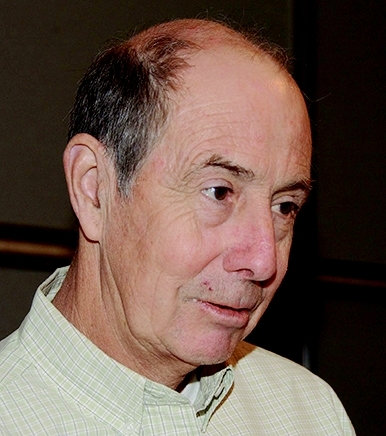
The drug is an inhibitor to the soluble epoxide hydrolase (sEH) enzyme, a key regulatory enzyme involved in the metabolism of fatty acids.
Panigraphy and Hammock said they are receiving “tons of calls, media requests and emails” from all over the world, including Norway, Japan, United Kingdom, Germany, France, Mexico and Belgium.
Pioneering research from the Panigrahy and Hammock labs shows that cell debris from surgery, chemotherapy, toxin exposure and other causes lead to production of high levels of pro-inflammatory mediators commonly called cytokines as well as eicosanoids.
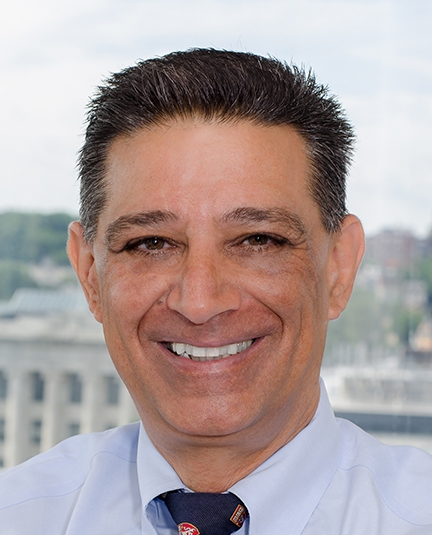
“A rapid immune response is critical to controlling this virus,” Panigrahy emphasized.
“We believe it holds promise to combat the inflammation involved with this disease,” said co-author Hammock, a UC Davis distinguished professor who holds a joint appointment with the Department of Entomology and Nematology and the UC Davis Comprehensive Cancer Center. “It hit me in March that what we really need to do is not so much block cytokines as to move upstream to modulate them and resolve them rather than block inflammation.”
“We can increase the concentration of natural pro-resolving mediators termed EETs which act on a biological system to produce other pro-resolution mediators which modulate inflammation and actively resolve the process,” explained Hammock, who founded the Davis-based company EicOsis Human Health LLC, to bring the inhibitor to human clinical trials, which are underway in Texas.
The co-authors include two physician-researchers: Patricia Sime of the Division of Pulmonary and Critical Care Medicine, Virginia Commonwealth University, Richmond, and Irene Cortés-Puch of the Division of Pulmonary, Critical Care and Sleep Medicine, UC Davis Medical Center, and an EicOsis project scientist.
“It is this resolution of inflammation and the subsequent repair that is critical to restore patient health,” said Serhan, whose studies with collaborator Sime show that immune resolution and repair are active processes in the lungs and other tissues. What drives the process, Serhan said, is the production of specific pro-resolving agents (SPMs).
Other co-authors of the paper are Molly Gilligan and Allison Gartung of the Panigrahy lab; Sui Huang of the Institute for Systems Biology, Seattle; and Richard Phipps, independent scholar, Richmond, Va.
National Institutes of Health (NIH) grants, including a National Institute of Environmental Health Science (River Award) to Hammock, helped fund the research. The Panigrahy laboratory is generously supported by the Credit Unions Kids at Heart Team; the C.J. Buckley Pediatric Brain Tumor Fund; and the Joe Andruzzi Foundation.
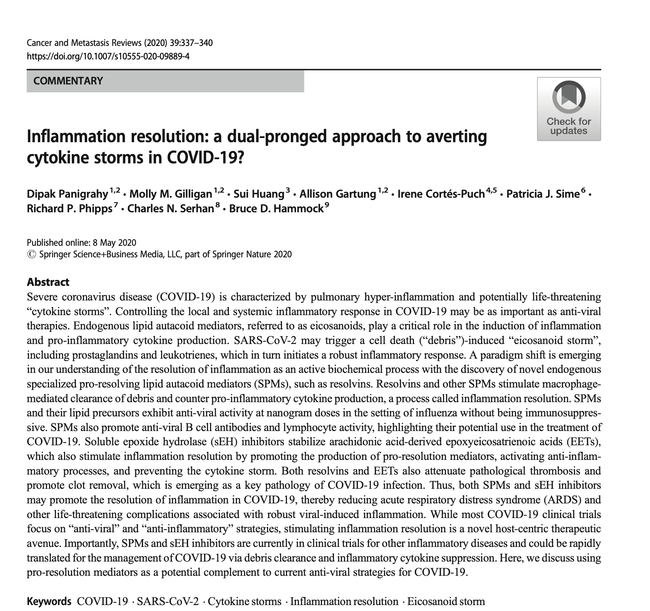
- Author: Kathy Keatley Garvey
(See commentary published in journal Cancer Metastasic and Reviews at https://rdcu.be/b33IN)
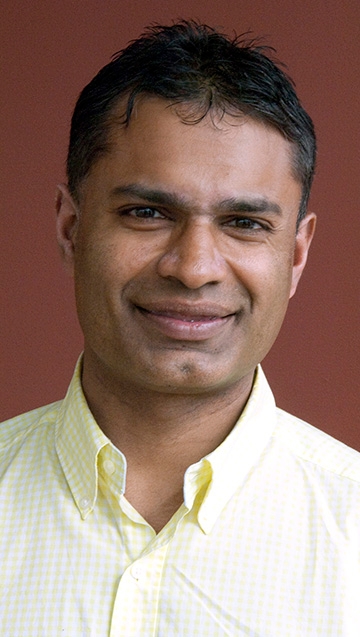
A drug discovered in the laboratories of Professors Charles Serhan of Harvard Medical School and Bruce Hammock of the University of California, Davis, may control the body's inflammatory response to COVID-10 and could help patients recover, according to a nine-member research team's newly published commentary in the journal Cancer Metastasis and Reviews, Springer Nature publishing group.
“COVID-19 results in excessive inflammation and a cytokine storm caused by the human body's reaction to the SARS-CoV-2 virus,” said lead author Dipak Panigrahy, a Harvard University physician and researcher who collaborates with the Hammock laboratory.
“Controlling the body's inflammatory response to COVID-19 will likely be as important as anti-viral therapies or a vaccine,” Panigraphy said. “Stimulation of inflammation resolutions via pro-resolution lipid mediators that are currently in clinical trials for other inflammatory diseases is a novel approach to turning off the inflammation and preventing the cytokine storm caused by COVID-19.”
“We propose that this drug will alleviate the cytokine storms that occur when the immune system is overwhelmed, when the patient is battling for survival,” Panigrahy said.
The drug is an inhibitor to the soluble epoxide hydrolase (sEH) enzyme, a key regulatory enzyme involved in the metabolism of fatty acids.
Editor-in-Chief and Professor Kenneth Honn selected their commentary, “Inflammation Resolution: a Dual-Pronged Approach to Averting Cytokine Storms in COVID-19?,” as the top paper of the month. The work is based on more than 40 years of eicosanoid research from the Hammock lab and more than 40 years of eicosanoid research from the Charles Serhan lab at Harvard Medical School.
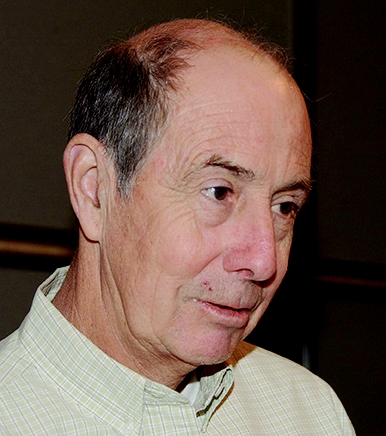
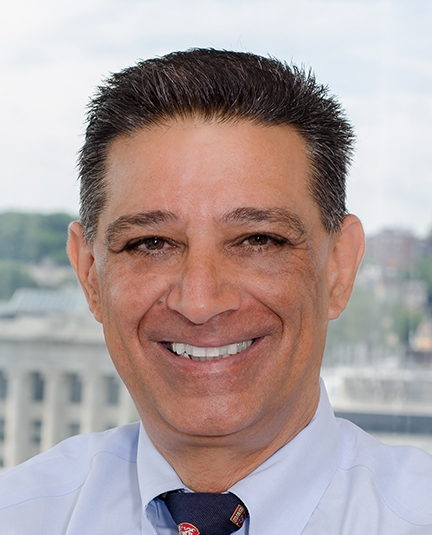
“The tremendous cell destruction caused by COVID in the lungs leads to cell debris, activating a series of events leading to the cytokine storm and mortality,” Panigrahy said. “Controlling inflammation is key to resolving any intense infection, and thus, desired treatments should modulate and particularly resolve inflammation.”
“A rapid immune response is critical to controlling this virus,” Panigrahy emphasized.
“We believe it holds promise to combat the inflammation involved with this disease,” said co-author Hammock, a UC Davis distinguished professor who holds a joint appointment with the Department of Entomology and Nematology and the UC Davis Comprehensive Cancer Center. “It hit me in March that what we really need to do is not so much block cytokines as to move upstream to modulate them and resolve them rather than block inflammation.”
“We can increase the concentration of natural pro-resolving mediators termed EETs which act on a biological system to produce other pro-resolution mediators which modulate inflammation and actively resolve the process,” explained Hammock, who founded the Davis-based company EicOsis Human Health LLC, to bring the inhibitor to human clinical trials, which are underway in Texas.
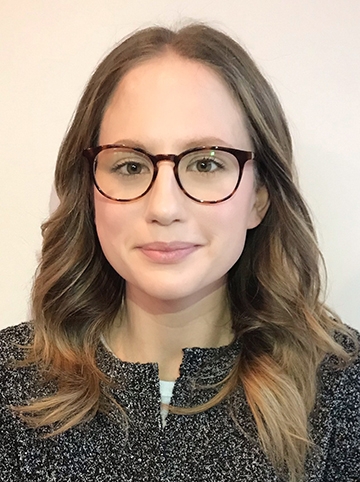
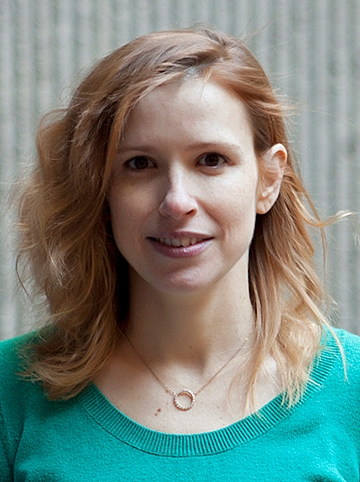
“It is this resolution of inflammation and the subsequent repair that is critical to restore patient health,” said Serhan, whose studies with collaborator Sime show that immune resolution and repair are active processes in the lungs and other tissues. What drives the process, Serhan said, is the production of specific pro-resolving agents (SPMs).
Puch, who did research at the National Institutes of Health (NIH) on acute respiratory distress syndrome (ARDS) and sepsis, said the drug should be effective in treating ARDS, which she defined as “a respiratory failure characterized by rapid onset of widespread inflammation in the lungs and common among seriously ill COVID-19 patients.”
“We think there are a series of control systems that fail to modulate the patient's response in COVID,” Cortés-Puch said. “The severe outcomes in some patients from the virus infection often are attributed to the cytokine storm, and blocking these cytokines represents a major therapeutic effort, which so far has failed. Our view is that we can move several steps upstream and control the cytokine storm not just at the level of individual cytokines and in doing so, we can encourage resolution of inflammation. In doing so, we can encourage resolution of inflammation.”
Said William Schmidt, EicOsis vice president of clinical development: “Our drug candidate has not caused any adverse effects at high doses in diabetic-hypertensive patients. Since this soluble epoxide hydrolase inhibitor acts upstream to down-regulate the eicosanoid and the cytokine storm, we are optimistic that it can help patients.” The Federal Drug Administration recently granted another EicOsis drug candidate a “fast track” status.
“In the meantime, we are looking at blood markers through time that are helping us to see the order of events leading from the original virus infection to the severe organ damage and cytokine storm that occurs in the most severe cases,” said Cindy McReynolds, a UC Davis doctoral student in pharmacology/toxicology, and EicOsis project manager.
Hammock said the UC Davis team began researching cytokine storms 16 years ago in projects based on the thesis of former doctoral student Kara Schmelzer. Now the UC Davis and Harvard scientists are targeting COVID-19.
Said Hammock: “In March, Cindy, Irene and I worked on a grant proposal with a group of scientists from the European Union to combine an anti-viral agent with an anti-inflammatory agent.”
“It hit me at that time,” Hammock reiterated, “that what we really need to do is not so much block cytokines as to move upstream to modulate them and resolve rather than block inflammation. We are lucky to have been working on such a resolving agent at UC Davis for decades.”
Other co-authors of the paper are Molly Gilligan and Allison Gartung of the Panigrahy lab; Sui Huang of the Institute for Systems Biology, Seattle; and Richard Phipps, independent scholar, Richmond, Va.
Much of the research was funded by NIH grants, including a National Institute of Environmental Health Science (River Award) to Hammock. The Panigrahy laboratory is generously supported by the Credit Unions Kids at Heart Team; the C.J. Buckley Pediatric Brain Tumor Fund; and the Joe Andruzzi Foundation.
Severe coronavirus disease (COVID-19) is characterized by pulmonary hyper-inflammation and potentially life-threatening “cytokine storms”. Controlling the local and systemic inflammatory response in COVID-19 may be as important as anti-viral therapies. Endogenous lipid autacoid mediators, referred to as eicosanoids, play a critical role in the induction of inflammation and pro-inflammatory cytokine production. SARS-CoV-2 may trigger a cell death (“debris”)-induced “eicosanoid storm”, including prostaglandins and leukotrienes, which in turn initiates a robust inflammatory response. A paradigm shift is emerging in our understanding of the resolution of inflammation as an active biochemical process with the discovery of novel endogenous specialized pro-resolving lipid autacoid mediators (SPMs), such as resolvins. Resolvins and other SPMs stimulate macrophage-mediated clearance of debris and counter pro-inflammatory cytokine production, a process called inflammation resolution. SPMs and their lipid precursors exhibit anti-viral activity at nanogram doses in the setting of influenza without being immunosuppressive. SPMs also promote anti-viral B cell antibodies and lymphocyte activity, highlighting their potential use in the treatment of COVID-19. Soluble epoxide hydrolase (sEH) inhibitors stabilize arachidonic acid-derived epoxyeicosatrienoic acids (EETs), which also stimulate inflammation resolution by promoting the production of pro-resolution mediators, activating anti-inflammatory processes, and preventing the cytokine storm. Both resolvins and EETs also attenuate pathological thrombosis and promote clot removal, which is emerging as a key pathology of COVID-19 infection. Thus, both SPMs and sEH inhibitors may promote the resolution of inflammation in COVID-19, thereby reducing acute respiratory distress syndrome (ARDS) and other life-threatening complications associated with robust viral-induced inflammation. While most COVID-19 clinical trials focus on “anti-viral” and “anti-inflammatory” strategies, stimulating inflammation resolution is a novel host-centric therapeutic avenue. Importantly, SPMs and sEH inhibitors are currently in clinical trials for other inflammatory diseases and could be rapidly translated for the management of COVID-19 via debris clearance and inflammatory cytokine suppression. Here, we discuss using pro-resolution mediators as a potential complement to current anti-viral strategies for COVID-19.
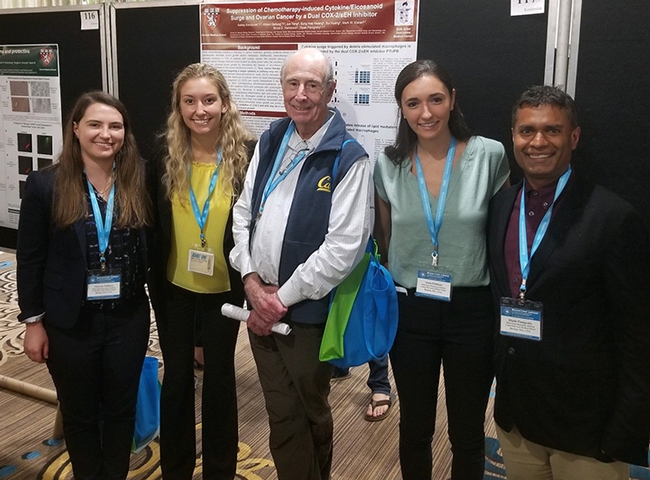
- Author: Kathy Keatley Garvey
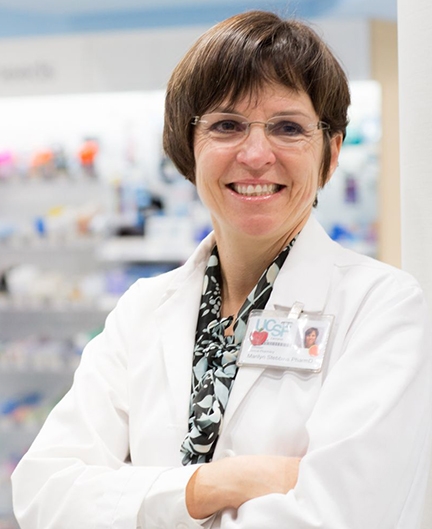
Marilyn Stebbins, 58, of Davis, a UC San Francisco pharmacist, will tell her story, announced webinar organizer-moderator Walter Leal, UC Davis distinguished professor of the Department of Molecular and Cellular Biology, College of Biological Sciences and former chair of the UC Davis Department of Entomology.
The webinar, to include experts in immunology, infectious diseases, pathology and emergency medicine, is free and open to the public. Registration is underway at http://zoompresentation.com, where advance questions can be submitted. The webinar also will include live questions.
Looking back, Stebbins related she began getting coldlike symptoms prior to a family skiing trip to Sandpoint, Idaho. An airline flight took her and her husband from Sacramento to Spokane, Wash. Upon returning home, she sought medical care for what she thought was the flu. She was tested for COVID-19 on March 3, and was informed March 4 she was positive. She was hospitalized for three days with what she calls the “worst illness I've ever had.”
In her story, “My COVID-19 Journey,” which appears on the UCSF School of Pharmacy website, https://bit.ly/2x1pqIe, Stebbins describes herself as “a healthy, fit, 58-year-old woman who enjoys distance trail running, weekly circuit training, and Pilates. I'd completed a 30K trail race just before the departure date for my vacation and looked forward to a 50K race two weeks after my return home.”
Controversy erupted when a Yolo County Health Department press release inaccurately described her as “an older woman with underlying health conditions.”
Stebbins said her symptoms included headache, diarrhea, nausea, coughing, and chills but “I never had a fever.” Family members, including her husband, who were with her on the skiing trip, have not contracted the disease.
The webinar is expected to draw a widespread audience. Chancellor Gary May will give the introduction. The main speakers are UC Davis physician-scientists Emanuel Maverakis, Stuart Cohen and Nathan Kuppermann; UC Davis veterinarian-scientist Nicole Baumgarth; physician Ron Chapman, Yolo County Health Officer; and pediatrician State Sen. Richard Pan, District 6 chair, Senate Committee on Health.
UC Davis distinguished professor James R. Carey of the Department of Entomology and Nematolgoy will share his scientific modeling expertise. UC Davis You-Lo Hsieh, distinguished professor, UC Davis Department of Biological and Agricultural Engineering, and an expert on textiles and clothing, will explain the differences between regular masks, surgical masks, and N95 masks.
